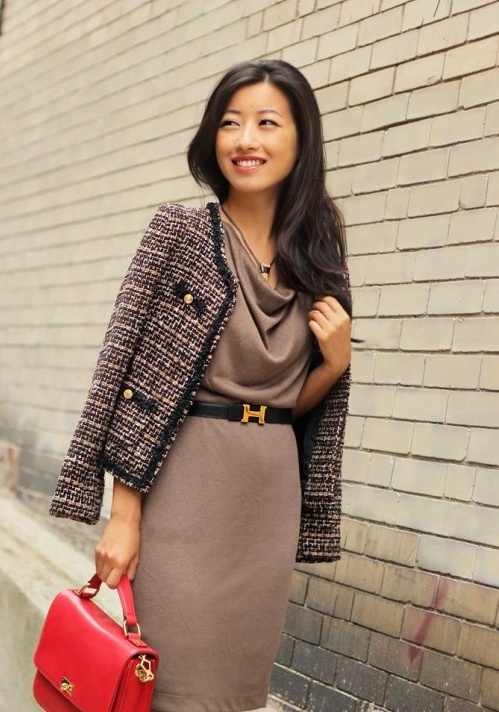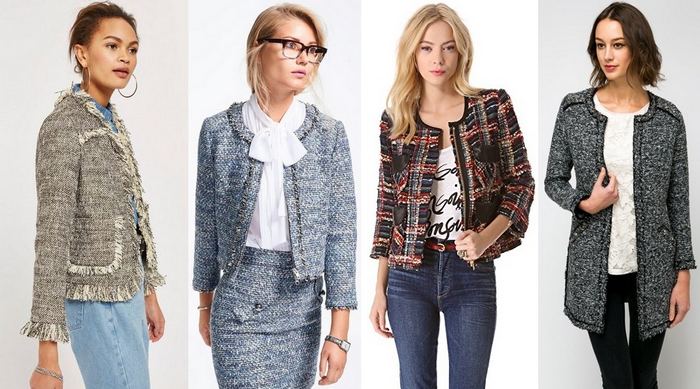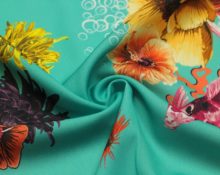There are models that go down in fashion history as symbols of a certain time or a famous fashion designer. These include the little black dress of the great Coco Chanel and her elegant bouclé suits. Voluminous fabric with an uneven surface once changed the way designers thought about how coats and suits should look., and since then has firmly taken root both in the women's wardrobe and in the interior design category.
Description and appearance
Bouclé is easily recognizable by its characteristic rough surface with protruding knots or loops. The fabric is quite loose and, therefore, soft and voluminous. Depending on the raw materials it is made from, bouclé can be quite dense, intended for coats or autumn suits, light and thin for the spring-summer season, cozy and knitted.
In its dense versions the surface of the material resembles the curls of scribble. It is no coincidence that the very name “boucle” translated from French means “curl”, “curl”, “ring”. The fabric can be monochrome or multi-colored.

Where was this fabric “born”? Manufacturing Features
The birthplace of bouclé is France. Exactly there the legendary Chanel in the mid-20th century offered its clients elegant suits, skirts and jackets made of new fabric. Making maximum use of the softness and plasticity provided by the matting-type interlacing of fibers of different shades, she created ensembles of delicate feminine shades, black and white options, used cheerful caramel tones and the most daring combinations.
By the way! Jacqueline Kennedy, Audrey Hepburn and Sophia Loren immediately became fans of this aristocratic style. Pays tribute to boucle models and Hillary Clinton.
Since the 70s, boucle coats have been at the peak of fashion. Karl Lagerfeld took up the initiative of the great Frenchwoman and made bouclé the face of his brand.
The highlight of the fabric is its roughness and convexity, which arises as a result of a special manufacturing technologyI. When weaving the fabric, crepe or fancy yarn is used. At the same time, the weft threads, and sometimes the warp threads, also have large knots or thickenings along the entire length. It is they, when weaving, that create the effect of tubercles on a soft and loose surface.
A denser boucle, intended for outerwear and jackets, is obtained as a result of patterned weaving from multi-colored threads. In this case, a pattern appears on the fabric. The most popular is the famous “houndstooth”; a melange or checkered version is often found.

Does it stretch or not?
Bouclé fabrics, especially those made from wool threads with the addition of synthetics, are a fairly flexible material. Due to its looseness, it has stretching property. Of course, bouclé cannot be compared to knitted or stretch fabric, but wearing a jacket made from this fabric won’t make you feel like you’re in a cardboard box.
Composition and properties of bouclé
Initially, bouclé fabric was wool. It is distinguished by lightness, softness and, despite its friability, high heat-saving properties. Today, soft fabric with an uneven texture can be made from various natural fibers: cotton, wool, silk.
Naturally, the source material determines the purpose of the bouclé fabric. Lightweight options made of silk, viscose or cotton are an excellent solution for a spring-summer wardrobe. The addition of synthetic fibers significantly increases the strength and wear resistance of the fabric. Here, the undisputed leadership belongs to polyester, which makes bouclé material indispensable for furniture upholstery, curtains, blankets, capes, etc.
Finally, bouclé yarn produces a soft, fluffy product that is pleasing to the eye and provides maximum comfort.

Advantages and disadvantages
Like any other fabric, both are present. But there are disproportionately more of the former. Experts focus on the following advantages of bouclé:
- Ease. The voluminous appearance of boucle products is deceptive. The fabric is really light and comfortable.
- Softness. Products made from this material guarantee a pleasant tactile sensation; there is no feeling of prickliness, hardness or irritation.
- Elasticity, which allows you to create models with a tight-fitting silhouette that beautifully emphasizes your figure.
- Dress bouclé drapes well, forming beautiful soft folds.
- Breathability simultaneously with the heat-protective properties of dense options.
- Wrinkle resistant. A wonderful quality that allows you to feel confident throughout the day, especially for women who are forced to spend most of their working time at the desk.
- Aesthetics. Products made from bouclé look both classically elegant and original.
- Diversity color palette and pattern.
- Uneven surface relief to a certain extent corrects possible errors made during sewing.

As for the disadvantages, one of them causes significant inconvenience when sewing a product and does not at all interfere with a woman who will wear a coat or dress made of bouclé. This fabric fraying when cutting and sewing. Therefore, experts recommend immediately processing the edges of the part after cutting.
Owners of elegant suits and dresses with a relief surface will have to choose jewelry very carefully, pay attention to bracelets, watches, and the presence of locks on the bag. The fact is that on this fabric puffs form very easily, which immediately give the product a sloppy appearance.
And one more factor that should definitely be taken into account: boucle fabric can visually increase the volume. Therefore, when choosing a model style, you should think about which places need to be emphasized using bouclé, and where this fabric will have to be abandoned.

Types of bouclé
Over the past half century, popular fabric has changed significantly and today amazes with its diversity. The appearance of the surface varies depending on the weaving technology, the fibers used and the color scheme:
- The classic version is characterized by the presence of pills, curls or knots and is obtained by using knotted yarn.
- Cut bouclé looks very interesting, characterized by a fluffy effect like short-haired fur, on the surface of which cut threads protrude. The thickness of bouclé varies from very thick, intended for outerwear, to thin silk bouclé, from which expensive summer clothes are sewn.
- The color scheme can also be different. Possible options:
- Monochrome color.
- Plain fabric interspersed with bright contrasting threads.
- Melange color.
- Chicken or goose foot.
- Cell.
- Strip.

Compare with other fabrics
Of course, other materials are also used to sew suits, jackets, and coats. Comparing them with bouclé, a couple of points can be noted.
Tweed is a very common suiting and coat fabric. As a rule, it is obtained by diagonal twill weaving of wool threads, which provides a rough surface of the material, different much higher density than bouclé. There is no need to talk about softness, plasticity and lightness in relation to tweed. That is why it is mainly used for sewing men's clothing.
The women's version of tweed involves the addition of linen, silk, cotton or synthetic threads, which makes it lighter.
Gabardine is very popular. This fabric is made from six Merino sheep in a diagonal weave, resulting in a bias rib on the smooth surface. This type of costume material shares with bouclé good drapability, lightness and resistance to wrinkles.

What are they sewing from this material?
- First of all - elegant two-piece “skirt + jacket” in Chanel style. A traditional option for bouclé fabric in plaid or houndstooth.
- Thick varieties of wool bouclé are intended for coats of various cuts, ponchos, and demi-season capes. Can be a great addition to your look beret and scarf made of soft fabric in a curlicue pattern.
- Thin varieties of boucle made from cotton or silk threads are transformed into a wide variety of summer outfits: dresses, sundresses, skirts, trouser suits etc. It is worth paying attention to the bouclé made of natural silk. This expensive fabric is used to make evening dresses for special occasions.
- The scope of application of bouclé fabrics made from synthetic fibers is very wide. First of all, it's beautiful furniture upholstery. They look no less convincing drapes and curtains.
- The densest varieties are used in shoe production for finishing and sewing slippers.

Bouclé jackets
Nuances of care
Care recommendations vary significantly depending on the composition of the fabric:
- Classic version of wool bouclé eliminates washing. The optimal solution is dry cleaning. At home, you can remove dirt with a soft brush.
- Other types of curly fabric can be washed using the delicate cycle at temperature not exceeding 30-40°. The automatic spin function should be abandoned by performing this procedure manually without twisting or stretching the product.
- You should dry bouclé clothes in the unfolded and straightened state. If ironing is necessary, this procedure is performed from the inside out at a minimum temperature through the substrate.
Important! Washing in the machine is done separately from other items.When loading the product, make sure that all zippers and buttons are fastened to avoid snags. The ideal option is to use a laundry bag.
Following these simple recommendations will ensure long-term use of your favorite items in your wardrobe.


 0
0





